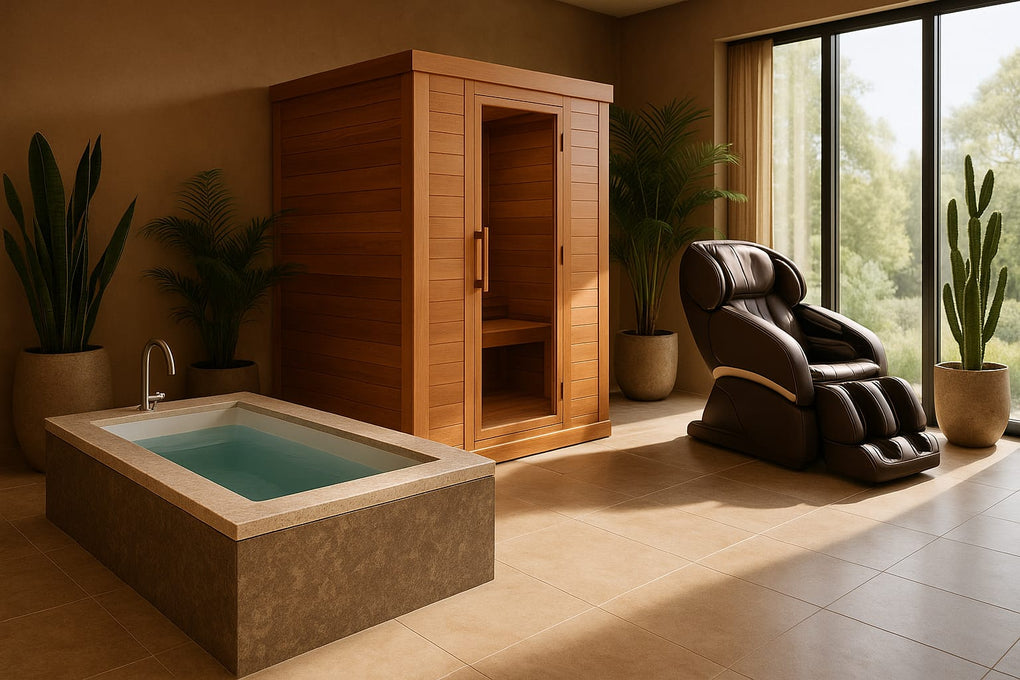A traditional sauna is more than a purchase—it’s a wellness sanctuary you’ll enjoy for years. This guide covers heater choices (wood-burning vs. electric), sizing your heater to your room, essential construction details, and the most popular upgrades so you can buy with confidence.

Wood-Burning vs. Electric Heaters
Wood-Burning Heaters
If you want the most authentic atmosphere—crackling fire, wood aroma, and soft löyly (steam)—a wood-burning heater is unmatched. It’s ideal for off-grid cabins or backyard saunas where you can accommodate a chimney and clearances.
- Pros: Traditional feel, no electricity needed, high radiant heat.
- Considerations: Requires chimney/flue, floor and wall clearances, spark protection, and a steady wood supply.
Explore wood-capable brands: Harvia, Narvi, LeisureCraft.
Electric Heaters
Electric heaters deliver precision and convenience—set temperature and time with a control panel or mobile app and enjoy consistent heat and faster warm-ups.
- Pros: Push-button operation, Wi-Fi options, precise controls, compact footprints.
- Considerations: Requires a dedicated electrical circuit (commonly 240V), and professional installation is recommended.
Shop popular electric options: HUUM, Harvia, Finnmark.
How to Size Your Heater to Your Sauna Room
Proper sizing ensures efficient heat-up times and quality löyly. Calculate your sauna room volume (Length × Width × Height in feet). Adjust for glass or stone by adding 25–50% to the effective volume if you have extensive non-insulating surfaces.
| Room Volume (cu. ft.) | Typical Heater kW | Notes |
|---|---|---|
| 100–175 | 3.6–4.5 kW | Compact, 1–2 users; consider small safety clearances. |
| 176–300 | 6.0–7.5 kW | Most home saunas; add capacity if you have large glass. |
| 301–425 | 8.0–9.0 kW | Faster heat-up, better recovery between steam pours. |
| 426–600 | 10.5–12.0 kW | Larger residential or light commercial rooms. |
Pro tip: Heaters with larger stone capacity (e.g., HUUM or select Harvia) create gentler, longer-lasting steam.
Essential Components & Materials
- Sauna Stones: Use natural, rounded stones designed for sauna heaters. (Shop accessories: HUKKA.)
- Benches: Two-tier layouts let users choose hotter (upper) or milder (lower) seating.
- Ventilation: Balanced supply and exhaust keeps oxygen fresh and heat uniform.
- Cladding & Framing: Kiln-dried cedar, spruce, or hemlock with proper vapor barriers.
- Door & Glass: Tempered sauna door; add glass panels for a modern, open feel.
- Controls: From simple dials to Wi-Fi systems for scheduling and remote start.
Installation, Power, & Venting Basics
Electric: Most residential electric heaters require a dedicated 240V circuit and appropriate amperage. A licensed electrician should install per local codes and manufacturer specs.
Wood-Burning: Requires a chimney/flue, spark protection, and clearances to combustibles. Follow local fire codes and manufacturer instructions.
Tip: Plan for a water source (for löyly) and consider a floor drain, especially for heavy use or commercial settings.
Optional Upgrades for a Luxury Experience
- Smart/Wi-Fi Controls: Start and monitor your sauna from your phone.
- Glass Fronts & Corner Windows: Expand sightlines and elevate the look.
- LED & Chromotherapy: Scene lighting to match your mood.
- Aromatherapy: Essential oil diffusers for eucalyptus, cedar, citrus, and more (see HUKKA accessories).
- Backrests & Headrests: Ergonomic supports for longer, more comfortable sessions.
- Exterior Cladding & Porch Kits: For outdoor units, add weather protection and style.
- Cold Plunge Pairing: Complete the ritual with a chiller or plunge tub (browse Penguin Chillers and cold plunge accessories).
- White-Glove Delivery & Assembly: Simplify freight, placement, and safe setup.

Buyer’s Checklist
- Room volume calculated (and adjusted for glass/stone).
- Heater type chosen (wood-burning vs. electric) and correctly sized kW.
- Electrical plan (or chimney/vent plan for wood) reviewed with a pro.
- Proper insulation, vapor barrier, and heat-tolerant cladding specified.
- Ventilation locations planned (supply & exhaust).
- Benches, backrests, and lighting layout confirmed.
- Stones and accessories selected (see accessories).
- Delivery path measured; consider white-glove/assembly.
- Warranty, service, and MAP best-price policies understood.
FAQ
How long does a traditional sauna take to heat up?
Typically 30–45 minutes, depending on room size, ventilation, heater kW, and stone mass. Larger stone beds warm more gradually but deliver superior steam quality.
Can I add a traditional sauna indoors?
Yes, with correct framing, insulation, vapor barrier, and ventilation. Electric heaters are most common indoors; always follow local code and manufacturer specs.
What maintenance is required?
Wipe benches, allow the room to dry after sessions, periodically re-stack or replace stones, and follow any flue cleaning schedule for wood-burning models.
Do you offer price protection?
We honor brand MAP policies and offer a best-price guarantee on all items.
Ready to build your sauna? Explore top heaters from HUUM and Harvia, then pair with benches, lighting, and HUKKA accessories. Need sizing help? Talk to our team—we’re happy to help.







Leave a comment